CHANUKA, OR THE FESTIVAL OF LIGHT

December 10-18, 2020
Hanukkah, also known as the Festival of Lights, is one of the most important and joyful holidays of Judaism. It is a movable holiday, the beginning of which is on the 25th day of the month of Kislev (its counterpart in the Gregorian calendar is November and December). For eight consecutive nights, more candles are lit in the so-called Hanukkah menorah, or candlestick. In 2020, Hanukkah starts on December 10 and will last until December 18, so the first candle in the menorah will be lit on December 10 in the evening. The feast of Hanukkah commemorates the miracle that happened in the Jerusalem Temple during the Jewish uprising against the Greeks during the reign of Antiochus IV.
Some history
Hanukkah is a holiday that strongly refers to the history of the Jewish people, and its origins date back to the 25th of Kislev in 165 BCE. Israel was then a conquered state that was part of the lands of the empire of Alexander of Macedon. Within the empire, the conquered peoples could practice their own religion and cultivate their native traditions, but this situation completely changed after Alexander of Macedon’s death in 320 BCE. The empire was divided, and Judea was taken over by the Greek Seleucid dynasty, an enemy of foreign cultures. The Seleucids, ruled by King Antiochus, imposed on the people of Israel both a Hellenic culture and a Greek, polytheistic religion. They especially opposed Jewish monotheism, according to which there was one invisible, abstract god – the opposite of Greek polytheism, with multiple gods taking the form of beautiful people or animals. The Greeks forbade Jews from traditional rituals, e.g. for circumcising a boy, he was threatened with public execution, they forbade the possession of the Torah, and finally in 167 BCE. a decree was issued transforming the Temple of Jerusalem into a place of worship of Zeus. The desecration of the temple affected the Jews so much that they launched a seven-year uprising against the Greeks led by the priest Matias. When, after the death of Matias, his son, Judah, known as Maccabee, took command of the uprising, the rebels were called Maccabees. The Jews finally succeeded in displacing the Greeks from Judea in 165 BCE, and the uprising ended with the independence of the Maccabean State in 142 BCE. This story is described in the Book of Maccabees, one of the Old Testament apocrypha.
Hanukkah miracle…
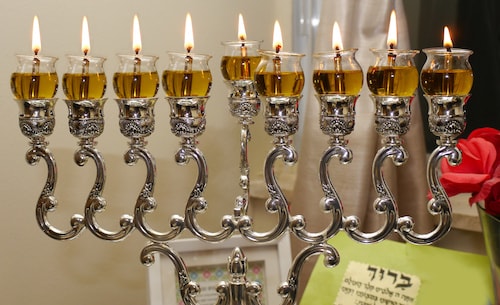
Of course, one of the most important achievements of the uprising, apart from independence from the Greeks, was the recovery of the Temple of Jerusalem. It was ritually cleansed and rededicated, as is remembered by the word “Chanukah”, literally meaning “sacrifice”. Where is the miracle in all this? Immediately after cleaning the temple, the priests noticed that the oil collected for the ritual candlestick was only enough for one day, and they had no supply. However, the candlestick miraculously burned for eight days, that is, so long that it was possible to easily stock up for the future. It is in memory of this event that eight more candles are lit during Hanukkah. The second miracle, of course, was to win the partial independence of Juda, and especially to save the religion, rituals, and cultural heritage of Judaism, which, subject to Hellenization, could completely disappear in the depths of history!
How is Hanukkah celebrated?
Hanukkah is a celebration of joy in which light plays a special role. For eight consecutive evenings, a candlestick is lit – a hanukkiah – with nine arms, one of which – the shamash (servant) – is used to hold an additional candle. In 2014, on December 16, it will start with the first candle, adding another candle every night until all eight candles are lit on the eighth last day. So first the shamash is lit, and then from left to right: the leftmost candle and then the rightmost candle. Candles must burn for at least thirty minutes, and they are lit either at sunset or when the first stars appear in the sky. Importantly, the “Hanukkah miracle” should be announced to the whole world, so the candlestick should be positioned so that it is visible to many people (e.g. in a window facing the street) or at the entrance to the house. The candlestick must not be used for any other purpose, e.g. to illuminate the house or to light something with a candle flame.
Hanukkiah
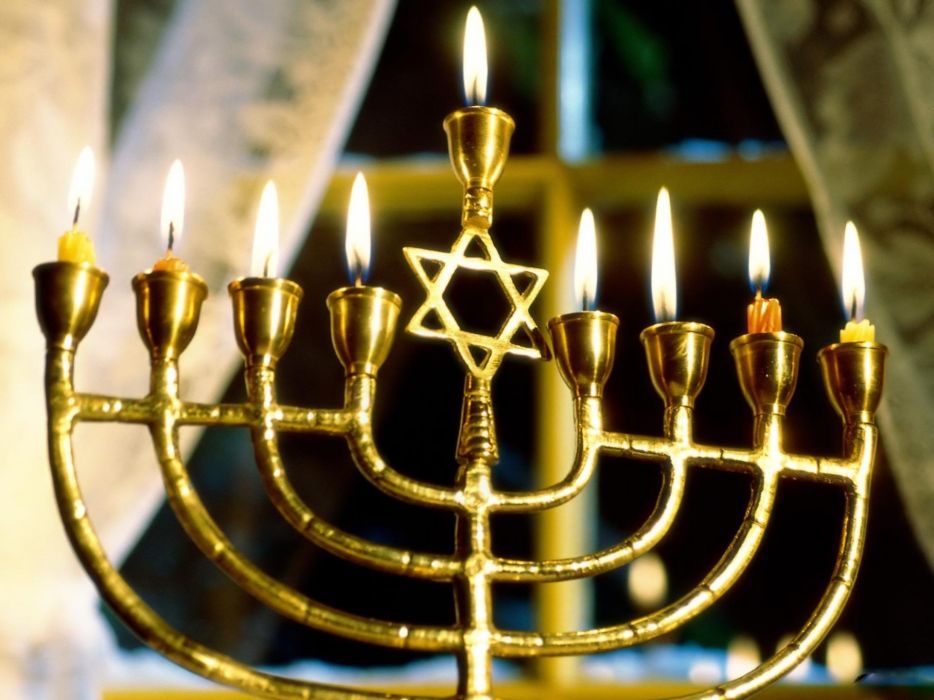
Typical nine-branched Hanukkah candlestick used in homes.
Usually one of the family members lights candles for the whole family (this is a typical Sephardic custom), it is customary to entrust this role to the mother, because women are held in special respect during this holiday. The blessings given by the person who light the candles are also especially important: on the first evening there are three blessings, on the following evenings – two.
After lighting the candles, everyone says the words Hanerot Halelu (These Lights), a text that explains the meaning of the ritual:
“We light these lights for miracles and signs, for salvation and for the battles you fought for our fathers in those days at this time, by your holy priests. All eight days of Hanukkah, these lights are holy. And we must not use them, but only look at them to thank and praise your great name, for your miracles and for your salvation and for your signs”.
In addition to the religious ritual, Hanukkah is also associated with caloric culinary pleasures. The most popular are, of course, extremely sweet Sufganiot, i.e. donuts stuffed with preserves and sprinkled with powdered sugar. Although it may surprise us, potato pancakes (latkes) are also traditional Hanukkah dishes. Deep frying (oil) combines both dishes, which again recalls the oil that miraculously lasted for a few days in a temple lamp. The custom of serving roasted goose (whose meat was high in fat) is becoming a thing of the past, while cheese dishes such as cheesecakes, pancakes with cheese, and buns are still enjoyed.
Traditional Hanukkah donuts, or Sufganiot…
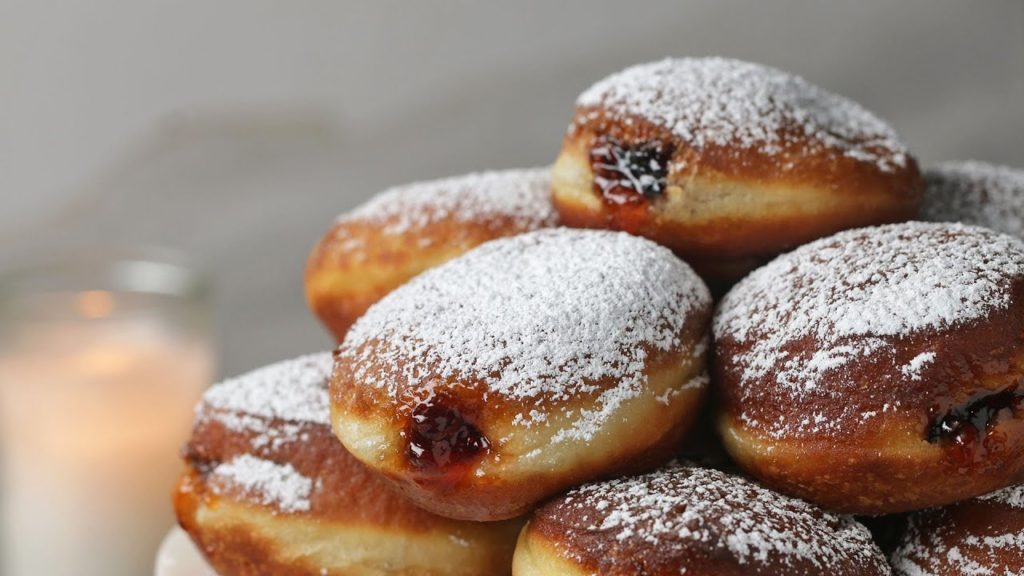
Latkes, i.e. potato pancakes fried in deep olive oil or oil…
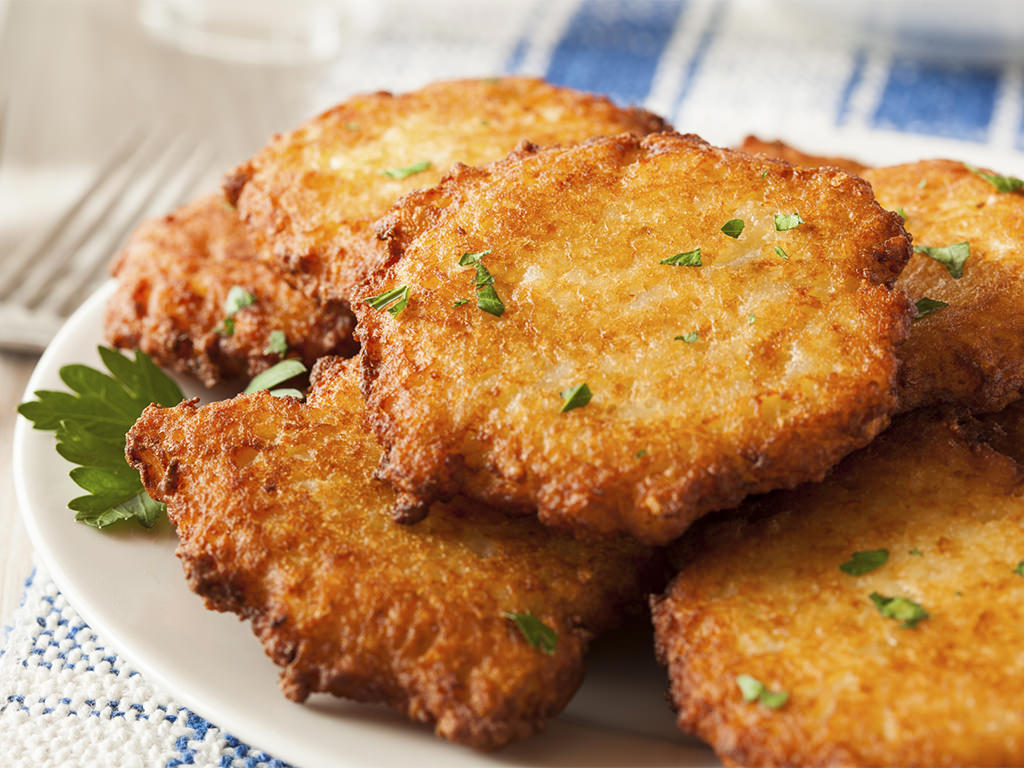
The cheese is a reference to another legend about the brave Judith. Judith offered cheese to Holofernes, the commander of the Assyrian army – the cheese caused him a great thirst, and it was Judith who tried to soothe with wine. When the drunk Holofernes fell asleep, she cut off his head and thus prevented the destruction of Israel.
Since Hanukkah is usually close to the Christian Christmas, there is also a custom of giving each other small gifts during this time. Sometimes the family plays dreidel (Yiddish), a spinning top with a single Hebrew letter on each side. Everyone has a certain number of coins or sweets in the game. All players return a coin or candies to the “bank”. Later, he turns the donut and takes his coins from the bank, or puts his coins into it, depending on which letter appears after the donut is stopped. The letter nun – means that everyone contributes to the “bank”, gimel – brings the whole bank to the spinning top, hey – corresponds to half, and shin – to return one item to the bank.
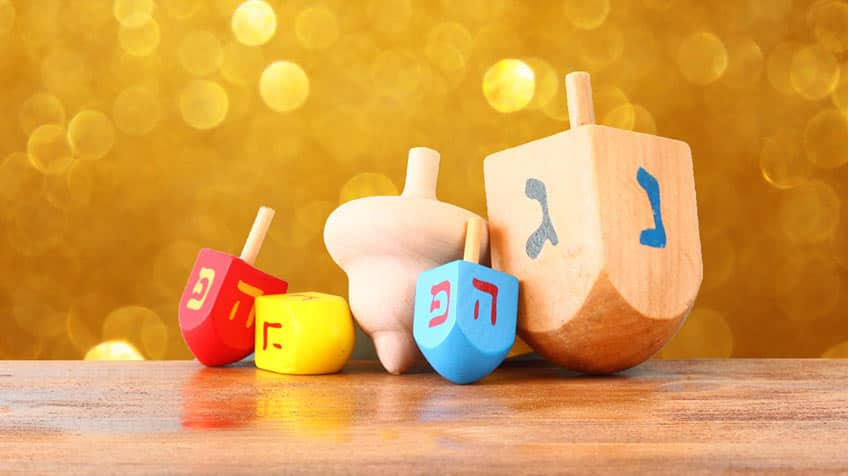


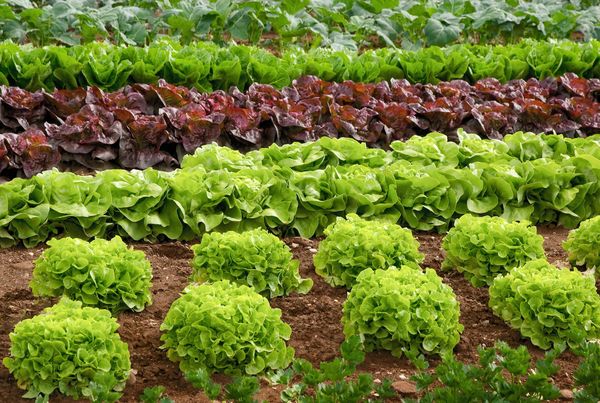

Very nice
Thank you !